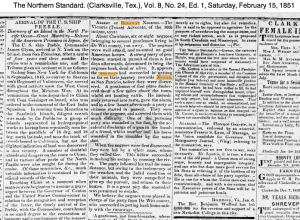“Juneteenth” is a holiday that memorializes June 19, 1865, when Union forces finally arrived in Texas and declared the end of slavery in the Lone Star state. It is also a telling reminder of how different slavery was in Texas.
These differences, as I discuss in my forthcoming book, were two fold. The first was Texas’s proximity to the Mexican border. For all the folklore about slaves following the north star and fleeing north to New England or Canada, most enslaved African Americans in the deep south did not head north but rather south into Mexico. Exact numbers are illusive, but anyone who has glanced at a Texas newspaper from the 1850s will encounter scores of fugitive slave announcements, all of them asserting that the runaways are headed to Mexico. (For an example, see below, from the Northern Standard from Clarksville, Texas, in 1851.) Towns such as Piedras Negras on the Mexican side of the border became well known collection points for escaped African Americans. That the south’s most dynamically growing slave state was located so close to a potential refuge for fugitive slaves generated great tensions in Texas, leading to both brutal treatment of slaves, to discourage them from running away, and frequent attacks against Tejanos, who were thought to be helping slaves to flee across the border.

The other difference was again geographic. As the most distant state of the Confederacy, Texas witnessed almost no combat during the Civil War. Indeed, in 1865 as the rest of the south was crumbling, slaves in Texas were planting yet another crop of cotton, and Jefferson Davis was hoping to flee to Texas to reconstitute the Confederate government and perhaps even link up with the French forces in Mexico. Slavery’s sudden end in Texas, with no major battles being fought on the Lone Star state’s soil, caused many white Texans to question the legitimacy of the Confederate surrender and made for an especially violent emancipation, even by the bloody standards of Reconstruction elsewhere.
The moral? Geography matters. Proximity to Mexico matters in particular. Slaves fled into Mexico seeking refuge; Confederates resupplied themselves from Mexico when all their other ports were blockaded by the Union navy; and, after the war, Confederates would again look south, hoping to rebuild slavery in Mexico.